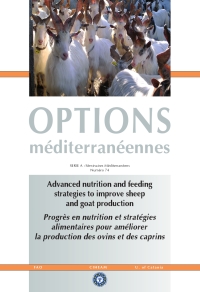| Article précédent | p. 83-87 | Article suivant |
Influence of organic systems on milk yield and quality of Cilentana goats
Forty-five multiparous pregnant Cilentana goats were equally divided into three groups. The first two groups (A and B), grazing natural pasture from 08:00 to 16:00 hours, received, respectively, the commercial concentrate (CP 18.0%, UFL, 1.03/kg DM) normally used on the farm where the trial was carried out and another (CP 17.0%, UFL 1.10/kg DM) made up only of raw materials from organic farming. The third group (C) received the same concentrate as group A but, during the whole trial period, was housed in a stall where it received alfalfa hay ad libitum as forage. The concentrates were fed at 200, 300 and 400 g/head/d, respectively 45, 30 and 15 days before parturition (beginning of February); then the quantities were increased up to 800 g/head/d. Once the kids were sold, two months after parturition, the milk yield was monitored monthly until the dry season for a total of 5 months. At each control, individual milk samples from the two daily milkings were analysed for protein, fat, lactose, casein and non-protein nitrogen contents. The milk yield did not statistically differ among the groups. However, group B, fed organic concentrate, showed higher milk yields than group A, which were fed non-organic concentrate, and overlapped yields in comparison to group C, housed in stalls (1432.7 vs 1418.1 g/d vs 1337.2 g/d, respectively for groups B, C and A). As regards milk chemical composition, the grazing groups showed significantly higher fat percentages (4.45 and 4.60 vs 3.79%, respectively for groups A, B and C; P<0.01), probably due to high roughage intake due to more intensive physical activity. The other chemical parameters showed no significant differences. Our results showed that the organic breeding of Cilentana goats did not induce a performance decrease: indeed, it can improve product yield in light of the exclusive use of goat milk for cheese making.
Quarante-cinq chèvres multipares Cilentana en gestation ont été distribuées en trois groupes égaux. Les deux premiers groupes (A et B), sur pâturage naturel de 08:00 à 16:00 h, ont reçu respectivement le concentré commercial (CP 18,0%, UFL, 1,03/kg matière sèche) qui était normalement utilisé à la ferme où a été mené l'essai, et un autre aliment (PB 17,0%, UFL 1,10/kg matière sèche) composé uniquement de matières premières provenant de l'agriculture biologique. Le troisième groupe (C) a reçu le même concentré que le groupe A sauf que, durant toute la période de l'essai, les animaux étaient en stabulation et recevaient du foin de luzerne à volonté comme fourrage. Les concentrés étaient distribués à raison de 200, 300 et 400 g/tête/j, respectivement 45, 30 et 15 jours avant la parturition (début février) ; ensuite les quantités augmentaient jusqu'à 800 g/tête/j. Après la vente des chevreaux, deux mois après la parturition, la quantité de lait était suivie mensuellement jusqu'à la saison sèche pendant un total de 5 mois. A chaque contrôle, on analysait les échantillons individuels de lait provenant des deux traites journalières pour connaître les teneurs en protéine, matière grasse, lactose, caséine et azote non protéique. La qualité du lait ne différait pas statistiquement entre les groupes. Cependant, le groupe B, recevant un concentré bio, a montré des quantités de lait supérieures à celles du groupe A, qui recevait un concentré non bio, et avec des quantités semblables à celles du groupe C en stabulation (1432,7 vs 1418,1 g/j vs 1337,2 g/j, respectivement pour les groupes B, C et A). Concernant la composition chimique du lait, les groupes en pâturage ont montré des pourcentages significativement supérieurs en matière grasse (4,45 et 4,60 vs 3,79 %, respectivement pour les groupes A, B et C; P<0,01), probablement dû à la forte ingestion de fourrage en raison d'une activité physique plus intense. Les autres paramètres chimiques n'ont pas montré de différences significatives. Nos résultats indiquent que la conduite en bio des chèvres Cilentana n'a pas induit de baisse des performances : en fait, ceci peut améliorer le rendement productif étant donné que le lait de chèvre est exclusivement utilisé pour la fabrication fromagère.
- [ Afficher ]
- [ Télécharger ]
- [ Exporter la citation ]
Vous pouvez télécharger la citation au format :
- [ Imprimer ]
-
Mots-clés
ALIMENTATION DES ANIMAUX, CHEVRE, EXPERIMENTATION, LAIT, PATURAGE, PRODUCTION LAITIERE, PRODUIT BIOLOGIQUE, QUALITE, REGIME ALIMENTAIRECiter cet article
Bovera F., Piccolo G., Calabrò S., Cutrignelli M.I., Zicarelli F., Infascelli F. Influence of organic systems on milk yield and quality of Cilentana goats. In : Priolo A. (ed.), Biondi L. (ed.), Ben Salem H. (ed.), Morand-Fehr P. (ed.). Advanced nutrition and feeding strategies to improve sheep and goat . Zaragoza : CIHEAM, 2007. p. 83-87. (Options Méditerranéennes : Série A. Séminaires Méditerranéens; n. 74). 11. Seminar of the FAO-CIHEAM Sub-Network on Sheep and Goat Nutrition, 2005/09/08-10, Catania (Italy). http://om.ciheam.org/om/pdf/a74/00800359.pdf



